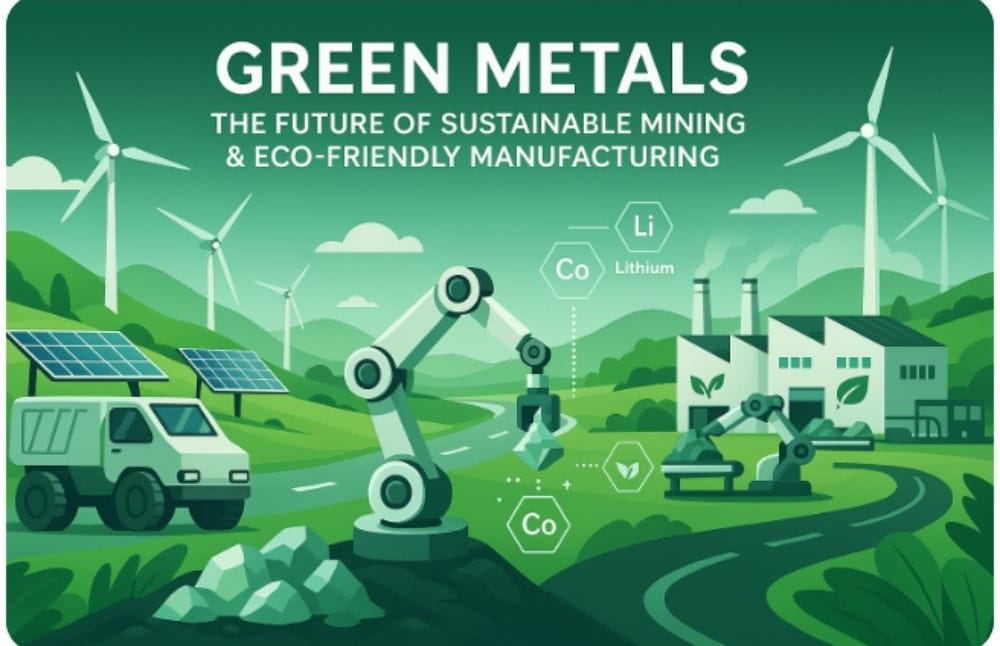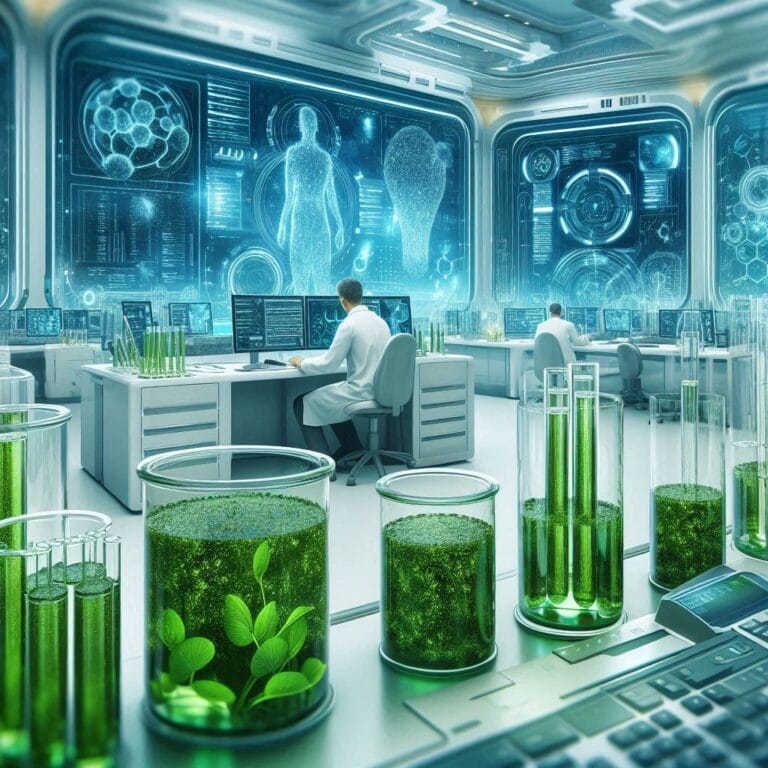Introduction: The Urgency for Green Metals
The global push for sustainability has made green metals a crucial element in modern industries. Traditional metal production is a major contributor to carbon emissions, resource depletion, and pollution, making Environmentally friendly metals alternatives essential.
The Environmental Impact of Traditional Metal Production
Metals such as steel, aluminum, and copper play a vital role in construction, automotive, and electronics industries. However, their production has severe environmental consequences:
- High Carbon Footprint: Metal manufacturing accounts for nearly 40% of all industrial greenhouse gas emissions and consumes 10% of global energy.
- Resource Depletion: Mining for raw materials leads to deforestation, soil erosion, and loss of biodiversity.
- Waste Generation: Traditional metal production generates large amounts of industrial waste, including toxic byproducts like sulfur dioxide and heavy metals.

The Rising Demand for Sustainable Metals
With industries shifting towards net-zero goals, the demand for eco-friendly metals is growing:
- Automotive Industry: The push for electric vehicles (EVs) has increased the demand for sustainably produced aluminum, lithium, and nickel.
- Construction Sector: Companies are adopting low-carbon steel and recycled metals to build energy-efficient structures.
- Electronics Manufacturing: Brands are prioritizing responsibly sourced metals for circuit boards and battery production.
What Makes a Metal “Green”?
A green metal is one that is produced with minimal environmental impact, either through energy-efficient methods, recycling, or sustainable mining. Key aspects include:
- Recycling & Circular Economy: Metals such as aluminum and steel can be recycled indefinitely, significantly reducing the need for new mining.
- Clean Production Methods: Technologies like electric arc furnaces (EAFs) and hydrogen-based steelmaking lower carbon emissions compared to traditional coal-based methods.
- Sustainable Sourcing: Ethical mining practices that minimize ecological damage and support biodiversity conservation.
The shift towards Environmentally friendly metals production is not just a necessity but an opportunity for industries to reduce costs, enhance efficiency, and contribute to a greener future.
Understanding Green Metals: What Sets Them Apart?
Defining Green Metals
Green metals, also known as environmentally friendly or low-carbon metals, refer to metals produced with minimal environmental impact. These metals are crucial for a sustainable future as they are either extracted using eco-friendly processes, recycled efficiently, or used in green energy technologies. Examples include aluminum, copper, lithium, nickel, cobalt, and rare earth elements, all of which are integral to clean energy solutions such as electric vehicles (EVs), wind turbines, and solar panels.
Traditional vs. Green Metal Production
The traditional mining and refining of metals involve high greenhouse gas emissions, extensive land degradation, and pollution. Conventional processes often rely on coal-powered energy sources and toxic chemical extraction methods, leading to significant carbon footprints.
In contrast, green metal production incorporates:
- Renewable Energy Usage: Mining companies are increasingly investing in wind, solar, and battery energy storage systems to power extraction and refining facilities.
- Electrification of Mining Equipment: Companies like Komatsu, Caterpillar, and Volvo are developing electric mining trucks and underground equipment to reduce fuel consumption.
- Energy-efficient Processing: AI-powered monitoring systems optimize energy use in mining operations, reducing emissions and improving sustainability.
Innovative Green Metal Extraction Methods
The future of green metals relies on sustainable mining innovations, including:
- Carbon Capture and Storage (CCUS): Capturing carbon emissions from smelting and mining operations to prevent them from entering the atmosphere.
- Green Hydrogen for Smelting: Hydrogen fuel, generated from renewable energy, is being tested as a cleaner alternative for smelting metals like steel.
- High-Density Pumped Hydro Storage: This method enables lower-impact energy storage for mining operations, reducing reliance on fossil fuels.
Recycling and Circular Economy
Recycling plays a critical role in sustainable metal production. For instance, recycling aluminum requires 95% less energy than primary extraction, significantly reducing emissions. Similarly, rare earth elements from used electronics and batteries are being recovered to reduce dependence on new mining.
Why Green Metals Matter?
With the global shift toward a low-carbon future, demand for green metals is skyrocketing. Countries like China, India, and Brazil are emerging as major players in producing key sustainable metals. However, the industry must balance the growing demand with responsible mining practices to mitigate environmental and social risks.
The push for green metals is not just about sustainability—it is also about economic and geopolitical strategy. Companies and nations investing in green metal technologies will be at the forefront of the clean energy transition. By adopting sustainable mining, recycling, and energy-efficient processing, industries can significantly lower their carbon footprint while securing a future-ready supply chain
Technologies Enabling Green Metal Production
The transition to sustainable metal production relies on groundbreaking technologies that significantly reduce carbon emissions and resource consumption. Below are the key technological advancements shaping the green metal industry today.
Hydrogen-Based Steelmaking: Replacing Coal with Hydrogen
Traditional steelmaking relies on coal in blast furnaces, releasing large amounts of CO₂. A more sustainable alternative is hydrogen-based direct reduction of iron ore (DRI), where hydrogen replaces coal. This method produces only water as a byproduct, making it an emission-free process when powered by green hydrogen from renewable energy sources.
The HYBRIT project in Sweden, a collaboration between SSAB, LKAB, and Vattenfall, is leading this transformation. HYBRIT’s process is expected to reduce Sweden’s CO₂ emissions by 10% when fully implemented. However, challenges remain, including the high demand for renewable electricity needed to produce green hydrogen at scale.

Electrolysis in Metal Production: A Clean Extraction Method
Electrolysis is emerging as a promising alternative for metal extraction. One of the most innovative developments in this field is molten oxide electrolysis (MOE), pioneered by Boston Metal. Unlike traditional smelting, MOE produces metals without carbon emissions and could significantly cut the costs of producing green steel. If scalable, this method could make green hydrogen less necessary for steel production.
Another method is aluminum electrolysis using renewable energy, which has been implemented in operations like Rio Tinto’s ELYSIS project. This technology eliminates direct greenhouse gas emissions from aluminum production, replacing them with pure oxygen.
AI & Machine Learning in Sustainable Metallurgy
Artificial intelligence (AI) and machine learning are playing a critical role in improving the efficiency of metal production. AI-powered software helps optimize energy use, predict equipment failures, and enhance recycling efficiency. For example:
- AI-driven automation in steel mills optimizes furnace operations, reducing fuel consumption and emissions.
- Smart sensors help identify high-quality scrap metal, ensuring efficient recycling and reducing reliance on virgin ores.
Waste Heat Recovery & Energy-Efficient Furnaces
Modern metal production is increasingly adopting waste heat recovery systems and high-efficiency furnaces to reduce energy consumption. Technologies such as Arvedi ESP (Endless Strip Production) enable steel plants to go from molten metal to finished products more efficiently, cutting down emissions and energy costs.
While significant progress has been made, the industry still faces hurdles, such as scaling hydrogen infrastructure, improving electrolysis efficiency, and reducing production costs. However, continued innovation and investment in these technologies will be key to making metals more sustainable.
Key Players & Industry Initiatives in Green Metal Production
Case Studies: Companies Integrating Green Metals
Major global companies are actively working to integrate green metals into their supply chains to reduce their carbon footprint.
- Apple has partnered with Alcoa and Rio Tinto to develop a carbon-free aluminum smelting process called Elysis. This process eliminates direct greenhouse gas emissions and instead emits oxygen. Apple has already started using this aluminum in its MacBook production, and the company has reduced its aluminum carbon footprint by 63% since 2015.
- Tesla is increasingly using low-carbon aluminum in its electric vehicles to make them more sustainable. The company works with suppliers that use renewable energy in the aluminum production process.
- BMW has committed to using green steel in its vehicles, sourced from manufacturers that use hydrogen-based steelmaking. This reduces carbon emissions significantly compared to traditional steel production.
Leading Companies in Sustainable Metal Production
Several companies are at the forefront of green metal innovation:
- ArcelorMittal: One of the world’s largest steel producers, ArcelorMittal is investing in hydrogen-based direct reduced iron (DRI) steelmaking to replace traditional blast furnaces.
- Norsk Hydro: A leader in green aluminum production, Norsk Hydro focuses on hydropower-driven smelting and extensive aluminum recycling programs to reduce emissions.
- Rio Tinto & Alcoa: These companies have pioneered the Elysis carbon-free aluminum project, with the first batch of commercial metal already produced.
Regulations and Policies Shaping Green Metal Adoption
Governments worldwide are pushing for greener metals through policies such as:
- Carbon Taxes & Emission Trading Systems: Many countries have introduced carbon pricing mechanisms that incentivize industries to adopt low-carbon alternatives.
- EU’s Green Deal & CBAM (Carbon Border Adjustment Mechanism): The European Union is imposing carbon tariffs on imported steel and aluminum with high emissions, encouraging global producers to adopt greener technologies.
- U.S. Infrastructure Bill: Includes incentives for domestic manufacturing of low-carbon steel and aluminum.
As demand for sustainable metals grows, companies across industries are integrating green metal technologies into their supply chains. Innovations like hydrogen-based steelmaking, carbon-free aluminum, and AI-driven emission reduction are shaping the future of metallurgy. Government policies are also accelerating this transition, making sustainable metal production an industry priority.
The Role of Recycling in the Green Metal Revolution
How Recycled Metals Reduce Mining Dependency
Recycling metals plays a crucial role in reducing reliance on mining, which is a major contributor to deforestation, habitat destruction, and water pollution. By reusing existing metal resources, industries can significantly cut down on the demand for newly mined materials. For example, recycling one ton of aluminum prevents the extraction of four tons of bauxite ore, reducing the environmental footprint of aluminum production. Similarly, steel recycling lessens the need for iron ore mining, reducing land degradation and carbon emissions.
Energy Savings of Recycling Aluminum, Copper, and Steel
Recycling metals requires far less energy compared to processing virgin ores. The energy savings are substantial:
- Aluminum: Recycling aluminum saves approximately 95% of the energy required to produce it from raw materials. This efficiency is why aluminum cans are among the most commonly recycled products.
- Steel: Recycling steel saves around 60-74% of energy, as it eliminates the need for extracting and refining iron ore.
- Copper: Recycled copper retains its high conductivity and requires up to 85% less energy compared to primary copper production.
These energy savings translate to lower greenhouse gas emissions, making metal recycling a key strategy in combating climate change.
Real-World Examples of High-Recycled-Content Products
Industries across various sectors are integrating recycled metals into their products to promote sustainability:
- Aluminum Cans: One of the most successful examples of circular economy metals, aluminum cans are often made with up to 70% recycled material, and they can be endlessly recycled without quality loss.
- Electric Vehicle Components: Companies like Tesla and BMW incorporate high-recycled-content aluminum and steel into their car bodies and battery casings, reducing the environmental impact of vehicle manufacturing.
- Construction Materials: Recycled steel and copper are widely used in green building projects, reinforcing structures with sustainable materials.
Challenges in Scaling Green Metal Production
High Production Costs & Need for Policy Incentives
While green metal recycling is energy-efficient, the initial investment in recycling infrastructure is expensive. High-tech sorting, melting, and refining systems require substantial funding. To make recycled metals more competitive, governments need to offer policy incentives such as subsidies, tax breaks, or carbon credits to encourage businesses to adopt sustainable practices.
Scalability of Green Technologies & Infrastructure Challenges
Despite advancements in hydrogen-based metallurgy and AI-driven sorting systems, green metal production faces infrastructure bottlenecks. Many recycling plants are not equipped to handle the increasing volume of metal waste, leading to inefficiencies in processing. Expanding recycling networks and modernizing facilities will be key to scaling up production.
Addressing Purity & Quality Concerns in Recycled Metals
One of the biggest challenges in metal recycling is contamination—when different metals mix, it becomes difficult to maintain material quality. Advanced refining technologies are needed to separate impurities and ensure recycled metals meet industry standards. Additionally, some high-tech industries (like aerospace and electronics) require ultra-pure metals, which recycled materials may not always meet.
Recycling metals is an essential strategy in the transition to sustainable metallurgy. It reduces mining dependency, conserves energy, and supports a circular economy. However, for green metal production to become mainstream, challenges like high costs, infrastructure limitations, and material purity must be addressed. By investing in new technologies and supportive policies, the industry can scale up recycling efforts and make green metals a standard in global manufacturing.
Future Trends & Innovations in Green Metallurgy
Advancements in Metal-Air Battery Technology
Metal-air batteries, particularly aluminum-air and lithium-air batteries, are gaining attention due to their high energy density and potential for cleaner energy storage. These batteries use metal as the anode and oxygen from the air as the cathode, making them lightweight and efficient. Researchers are focusing on improving the recyclability of metal-air batteries to make them more sustainable.
New Electrolysis Techniques for More Efficient Metal Extraction
Electrolysis-based metal refining is emerging as a promising alternative to traditional smelting, which emits large amounts of carbon dioxide. MIT researchers have developed molten oxide electrolysis, a method that can extract metals like iron without carbon emissions. This technique has the potential to revolutionize steel production, replacing coal-fired blast furnaces with clean electricity-driven processes.
Impact of Blockchain on Metal Supply Chain Transparency
Blockchain technology is playing a growing role in ensuring transparency and ethical sourcing in metal supply chains. Companies are leveraging blockchain to track the origin of raw materials, ensuring they are mined using sustainable practices. This innovation helps combat illegal mining, reduce fraud, and encourage responsible sourcing.
Future Market Potential & Investment Opportunities in Green Metals
The green metals market is expected to grow significantly as industries transition to Environmentally friendly metals. Investment in sustainable mining practices is increasing, with major players incorporating renewable energy into mining operations. Companies like Rio Tinto are investing in solar-powered mining projects, and electrified mining trucks are being developed to reduce carbon emissions.
Conclusion: A Call to Action for eco-friendly metal Use
Key Takeaways:
Importance of Adopting Green Metals Across Industries
The shift toward green metals is crucial for reducing industrial carbon footprints. Industries like automotive (electric vehicles), electronics, and construction are already integrating sustainable materials to lower emissions.
How Consumers and Businesses Can Contribute
- Businesses can prioritize suppliers that use sustainable metal extraction and recycling processes.
- Consumers can support companies that utilize recycled metals and eco-friendly materials in their products.
- Governments can introduce stricter environmental regulations and incentives for green metallurgy.
Final Thoughts on the Transition to a Low-Carbon Metal Economy
The future of metallurgy lies in innovation, policy support, and market-driven demand for sustainable materials. As technological advancements like hydrogen-based steelmaking, AI-driven resource efficiency, and carbon-neutral mining techniques develop, a greener metal industry will become a reality.
🌿 Explore More on Sustainable Innovations:
If the future of green metals sparked your curiosity, don’t miss these groundbreaking reads that dive deeper into sustainability and next-gen materials:
🔹 Dark Oxygen: Mining Seabed for Battery Materials – Uncover the mysteries of deep-sea mining and how it could power the next generation of clean energy.
🔹 Advanced Energy Materials – Discover the cutting-edge materials shaping the energy tech of tomorrow—from supercapacitors to solar breakthroughs.
🔹 Home Fuel Cells: Sustainable Energy for Modern Homes – Learn how home-based fuel cells are revolutionizing residential energy systems.
🔹 Liquid Crystal Elastomers – Explore the future of flexible and responsive materials that could transform industries from medicine to robotics.







